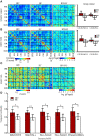Atypical Resting-State Functional Connectivity Dynamics Correlate With Early Cognitive Dysfunction in HIV Infection
- PMID: 33519683
- PMCID: PMC7841016
- DOI: 10.3389/fneur.2020.606592
Atypical Resting-State Functional Connectivity Dynamics Correlate With Early Cognitive Dysfunction in HIV Infection
Abstract
Purpose: Previous studies have shown that HIV affects striato-cortical regions, leading to persisting cognitive impairment in 30-70% of the infected individuals despite combination antiretroviral therapy. This study aimed to investigate brain functional dynamics whose deficits might link to early cognitive decline or immunologic deterioration. Methods: We applied sliding windows and K-means clustering to fMRI data (HIV patients with asymptomatic neurocognitive impairment and controls) to construct dynamic resting-state functional connectivity (RSFC) maps and identify states of their reoccurrences. The average and variability of dynamic RSFC, and the dwelling time and state transitioning of each state were evaluated. Results: HIV patients demonstrated greater variability in RSFC between the left pallidum and regions of right pre-central and post-central gyri, and between the right supramarginal gyrus and regions of the right putamen and left pallidum. Greater variability was also found in the frontal RSFC of pars orbitalis of the left inferior frontal gyrus and right superior frontal gyrus (medial). While deficits in learning and memory recall of HIV patients related to greater striato-sensorimotor variability, deficits in attention and working memory were associated with greater frontal variability. Greater striato-parietal variability presented a strong link with immunologic function (CD4+/CD8+ ratio). Furthermore, HIV-infected patients exhibited longer time and reduced transitioning in states typified by weaker connectivity in specific networks. CD4+T-cell counts of the HIV-patients were related to reduced state transitioning. Conclusion: Our findings suggest that HIV alters brain functional connectivity dynamics, which may underlie early cognitive impairment. These findings provide novel insights into our understanding of HIV pathology, complementing the existing knowledge.
Keywords: HIV-associated neurocognitive disorders; brain resting-state functional connectivity dynamics; fMRI; functional connectivity; temporal variability.
Copyright © 2021 Nguchu, Zhao, Wang, Li, Wei, Uwisengeyimana, Wang, Qiu and Li.
Conflict of interest statement
The authors declare that the research was conducted in the absence of any commercial or financial relationships that could be construed as a potential conflict of interest.
Figures




Similar articles
-
Altered cerebro-cerebellum resting-state functional connectivity in HIV-infected male patients.J Neurovirol. 2018 Oct;24(5):587-596. doi: 10.1007/s13365-018-0649-x. Epub 2018 May 21. J Neurovirol. 2018. PMID: 29785582
-
Connectivity pattern differences bilaterally in the cerebellum posterior lobe in healthy subjects after normal sleep and sleep deprivation: a resting-state functional MRI study.Neuropsychiatr Dis Treat. 2015 May 26;11:1279-89. doi: 10.2147/NDT.S84204. eCollection 2015. Neuropsychiatr Dis Treat. 2015. PMID: 26064046 Free PMC article.
-
Altered regional homogeneity and functional connectivity of brain activity in young HIV-infected patients with asymptomatic neurocognitive impairment.Front Neurol. 2022 Oct 10;13:982520. doi: 10.3389/fneur.2022.982520. eCollection 2022. Front Neurol. 2022. PMID: 36303561 Free PMC article.
-
Changes in thalamic connectivity in the early and late stages of amnestic mild cognitive impairment: a resting-state functional magnetic resonance study from ADNI.PLoS One. 2015 Feb 13;10(2):e0115573. doi: 10.1371/journal.pone.0115573. eCollection 2015. PLoS One. 2015. PMID: 25679386 Free PMC article.
-
Resting-state fMRI signals in offspring of parents with bipolar disorder at the high-risk and ultra-high-risk stages and their relations with cognitive function.J Psychiatr Res. 2018 Mar;98:99-106. doi: 10.1016/j.jpsychires.2018.01.001. Epub 2018 Jan 8. J Psychiatr Res. 2018. PMID: 29331931
Cited by
-
Cortico-striatal networking deficits associated with advanced HIV disease and cocaine use.J Neurovirol. 2023 Apr;29(2):167-179. doi: 10.1007/s13365-023-01120-8. Epub 2023 Feb 21. J Neurovirol. 2023. PMID: 36809507 Free PMC article.
-
HIV-1 Tat protein alters medial prefrontal cortex neuronal activity and recognition memory.iScience. 2025 Feb 22;28(3):112075. doi: 10.1016/j.isci.2025.112075. eCollection 2025 Mar 21. iScience. 2025. PMID: 40160418 Free PMC article.
-
Neuroimaging advances in neurocognitive disorders among HIV-infected individuals.Front Neurol. 2025 Feb 13;16:1479183. doi: 10.3389/fneur.2025.1479183. eCollection 2025. Front Neurol. 2025. PMID: 40017532 Free PMC article. Review.
-
Decoding HIV-associated neurocognitive disorders: a new perspective from multimodal connectomics.Front Neurol. 2025 Jan 29;16:1467175. doi: 10.3389/fneur.2025.1467175. eCollection 2025. Front Neurol. 2025. PMID: 39944538 Free PMC article. Review.
-
Examining Brain Function Changes in HIV-Infected Patients With Asymptomatic Neurocognitive Impairment: A Longitudinal Study.Brain Behav. 2025 Jun;15(6):e70559. doi: 10.1002/brb3.70559. Brain Behav. 2025. PMID: 40566924 Free PMC article.
References
LinkOut - more resources
Full Text Sources
Other Literature Sources
Research Materials
Miscellaneous

